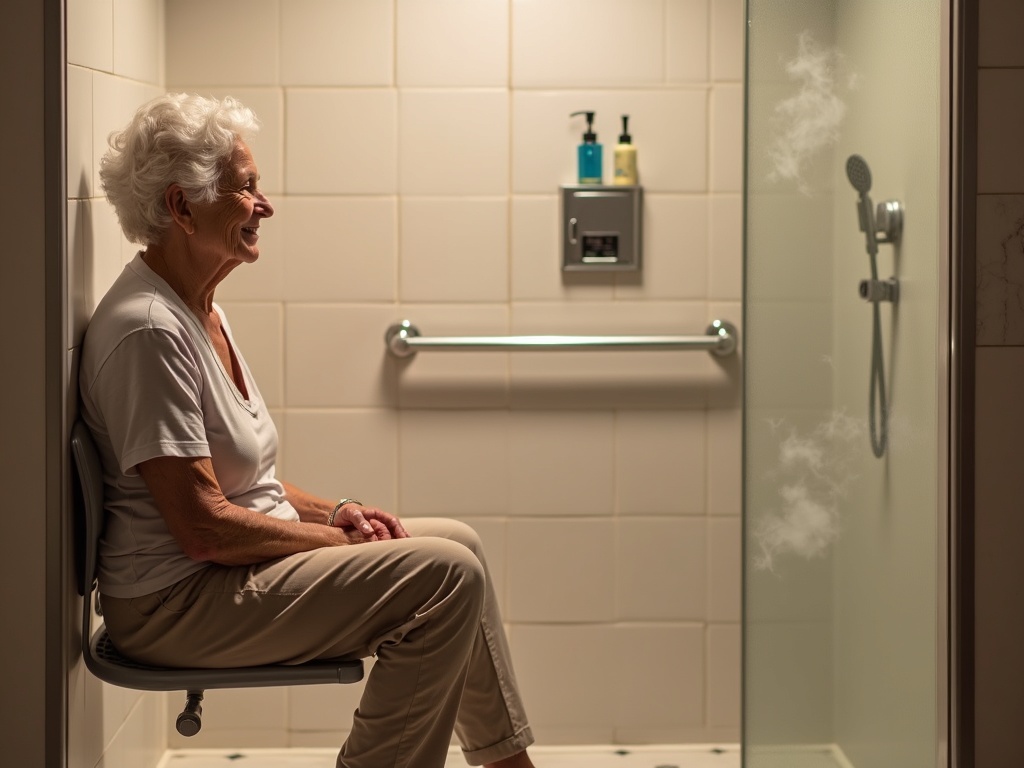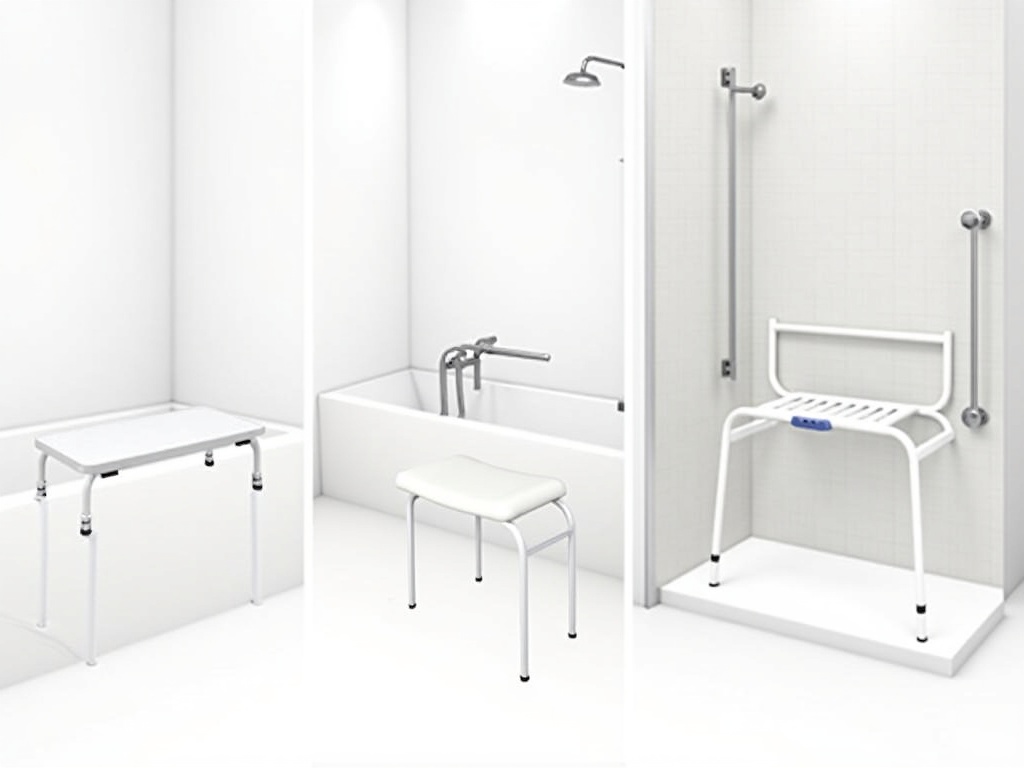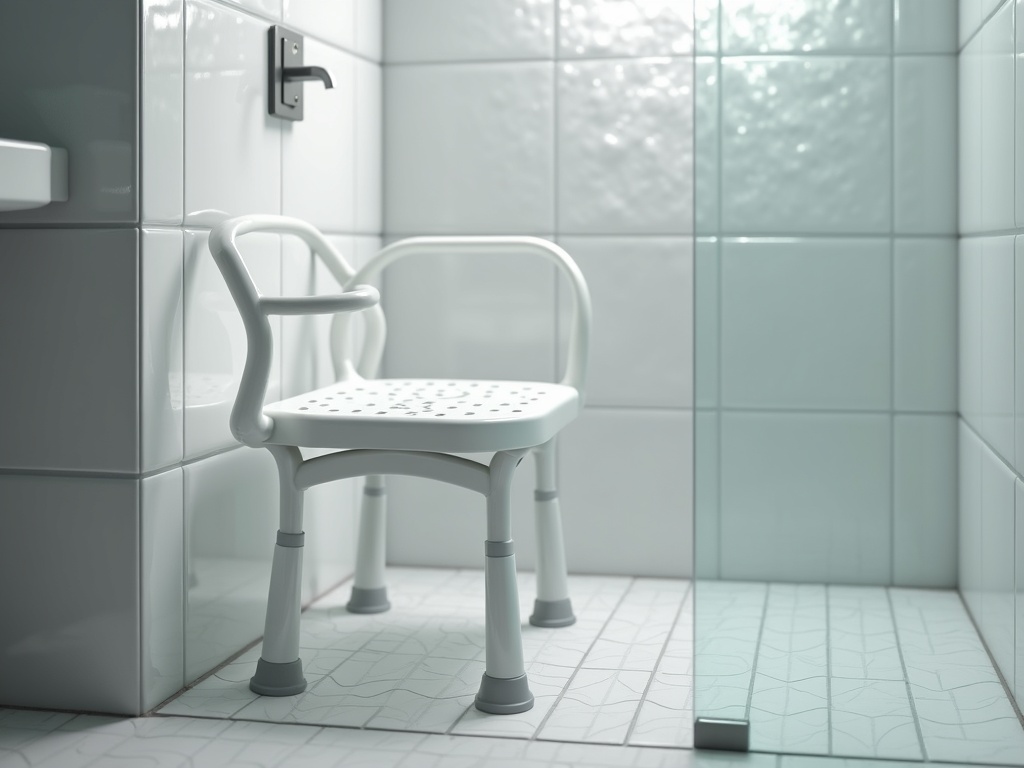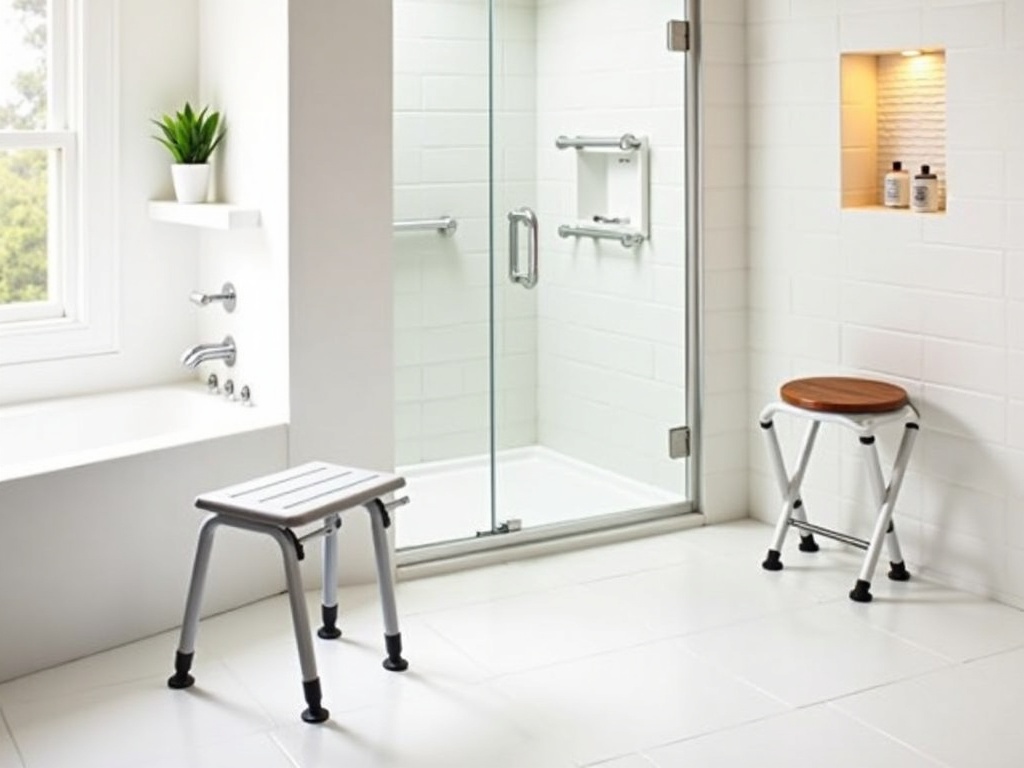Shower Seat
What Is The Best Shower Seat For Elderly Safety
Choosing the best shower seat for elderly safety demands attention to fall prevention features, with bathroom-related incidents making up over one-third of approximately 3 million annual emergency department visits by older adults. The right shower seat transforms bathing from a high-risk activity into a secure, manageable routine that supports independent living and aging in place.
Key Takeaways
- Transfer benches offer the highest safety level for users with significant mobility challenges. These benches eliminate the need to step over tub walls while providing stable support during transitions.
- Weight capacity should exceed the user’s weight by at least 50 pounds to account for dynamic forces. Most quality models support 300–400 pounds through anodized aluminum construction.
- Essential safety features include non-slip feet with wide contact areas, adjustable height settings, drainage holes, and supportive armrests that provide leverage for safe transfers.
- Wall-mounted shower seats require professional installation into wall studs to achieve stated weight capacities and offer a permanent, space-saving solution for elderly users.
- Material selection impacts both safety and longevity, with anodized aluminum frames and blow-molded plastic seats offering the best combination of durability, hygiene, and corrosion resistance.
Preventing Elderly Falls: Why Shower Seats Matter
Falls represent one of the most serious health threats facing older adults today, with the bathroom ranking as the most dangerous room in the home. I’ve seen firsthand how wet and slippery surfaces create treacherous conditions that can instantly transform a routine shower into a life-changing emergency. The statistics from the U.S. Centers for Disease Control and Prevention reveal the stark reality: falls are the leading cause of injury and injury-related death among adults aged 65 and older.
The numbers paint a sobering picture of bathroom-related incidents. Each year, approximately 3 million older adults receive emergency department treatment for fall injuries, with over one-third of these accidents occurring during bathing and transferring activities in the bathroom. These falls don’t just result in bruises and scrapes – they often lead to hip fractures, head injuries, and a devastating loss of independence that can forever alter an elderly person’s quality of life.
The Critical Role of Shower Seats in Fall Prevention
A shower seat transforms the bathing experience from a high-risk balancing act into a secure, manageable activity. I recommend these safety devices because they provide a stable, non-slip surface that eliminates the need to stand on wet bathroom floors while washing. This simple addition can mean the difference between maintaining independence and facing a lengthy recovery from a serious fall.
The benefits extend far beyond basic safety. Shower seats help conserve precious energy for individuals dealing with limited strength, reduced endurance, or compromised balance. Instead of struggling to remain upright throughout an entire shower, elderly users can sit comfortably while maintaining their personal hygiene routine. This energy conservation proves especially valuable for those managing chronic conditions like:
- Arthritis
- Parkinson’s disease
- Heart conditions
Supporting Independent Living and Aging in Place
Installing a quality shower seat often allows seniors to continue living independently in their own homes rather than moving to assisted living facilities. I’ve witnessed how this single modification can extend a person’s ability to age in place by several years. The psychological benefits are equally important – maintaining the ability to shower independently preserves dignity and self-confidence during a time when many daily activities become increasingly challenging.
The investment in a proper wall-mounted shower seat pays dividends in both safety and peace of mind. Families can rest easier knowing their loved ones have reduced their fall risk significantly. For seniors themselves, the confidence that comes from having a secure place to sit during bathing can eliminate the anxiety that often accompanies shower time.
Different types of shower seats serve various needs and bathroom configurations:
- Recessed shower seats offer a streamlined solution for those who prefer a built-in appearance
- Folding options provide space-saving benefits when not in use
The key lies in choosing the right style and ensuring proper installation.
Professional installation becomes crucial for maximizing safety benefits. A poorly mounted seat can create false confidence and potentially cause more harm than good. I always emphasize the importance of having professional installation to ensure the seat can support the user’s weight and withstand daily use.
The evidence clearly shows that shower seats aren’t luxury items – they’re essential safety equipment for elderly individuals. With bathroom falls accounting for such a significant portion of senior injuries, every family should seriously consider this relatively inexpensive modification. The cost of prevention pales in comparison to the physical, emotional, and financial toll of a serious fall injury.

Types of Shower Seats: Finding Your Perfect Match
I’ll guide you through the four main types of shower seats, each serving different needs and mobility levels. Understanding these options helps you select the right solution for your specific circumstances.
Basic Options: Stools and Chairs
Shower stools provide the most basic seating option. These simple, backless, and armless seats work best for small showers and users who have good balance and core strength but need a place to rest. I recommend stools when space constraints make larger options impractical. Their compact and portable design makes them easy to move or store, but they offer minimal support for getting in and out of the seated position.
Shower chairs deliver significantly more support than stools. Features like a backrest and armrests offer crucial support points for pushing up to a standing position and preventing sideways slips. The addition of a back and arms provides the stability needed for users who struggle with balance but can still step into the shower independently. I find these chairs strike an excellent balance between support and flexibility for many elderly users.
Advanced Support Solutions
Transfer benches represent the gold standard for individuals who use a walker or wheelchair or have difficulty lifting their legs. These long benches feature two legs that sit inside the tub and two that sit outside, eliminating the need to step over the tub wall. Users sit on the portion outside the tub, then scoot over and swing their legs into the tub, avoiding the high-risk action of stepping over the tub ledge. This design makes transfer benches the safest option for users with significant mobility challenges.
Wall-mounted shower seats offer permanent installation directly onto the shower wall. These seats can be folded up when not in use, providing excellent space-saving benefits. I emphasize that professional installation is non-negotiable to ensure secure anchoring to wall studs. Installing wall-mounted seats properly ensures they remain stable and safe for daily use.
Recessed shower seats integrate directly into the shower wall during construction or renovation, creating a seamless appearance. Folding wall-mounted options provide the convenience of a permanent fixture that doesn’t obstruct the shower space when not needed.
Wall-mounted seats typically have a weight capacity ranging from 250 to 500 pounds, depending on the model and installation quality. This makes them suitable for users of various sizes, provided the installation meets manufacturer specifications.
I recommend considering your current mobility level and potential future needs when selecting between these options. Senior wall-mounted shower seats often provide the best long-term value for those planning to age in place. Elderly-specific designs incorporate features that address common challenges faced by older adults.
Each type serves different mobility levels and bathroom configurations:
- Stools work for those needing minimal assistance.
- Chairs provide moderate support.
- Transfer benches accommodate significant mobility limitations.
- Wall-mounted seats offer permanent, space-efficient solutions.
Consider your specific needs, bathroom layout, and installation preferences when making your selection.

Critical Safety Features You Shouldn’t Compromise On
When I evaluate shower seats for elderly users, I focus on specific safety features that can mean the difference between a secure bathing experience and a dangerous fall. These aren’t luxury add-ons – they’re essential safety components that protect your loved ones every time they shower.
Essential Safety Components for Maximum Protection
I always examine these critical features when recommending shower seating:
- Non-slip feet with substantial contact area – Standard rubber caps fail under wet conditions. I recommend wide, flared, or suction-style feet that create maximum surface contact with your shower floor. Look for feet with a flared base measuring at least 1.25 inches in diameter, as this specification provides superior grip and prevents dangerous sliding on wet surfaces.
- Proper adjustable height settings – Generic heights create unsafe positioning. The correct seat height allows feet to rest flat on the floor while maintaining knees at a 90-degree angle. This ergonomic positioning reduces strain on the back and knees during transfers and provides the proper leverage needed to stand safely.
- Drainage holes and textured surfaces – Water pooling creates slip hazards and allows soap residue to accumulate, potentially causing skin irritation. I insist on seats with strategically placed drainage holes that prevent water accumulation while a textured surface provides additional grip security.
- Supportive armrests for safe transfers – These aren’t comfort features – they’re critical safety tools. Armrests provide essential leverage for lowering onto the seat and pushing up safely. This support becomes increasingly important as mobility decreases with age.
The combination of these features creates a comprehensive safety system. I’ve seen too many accidents occur when people compromise on these specifications to save money or choose based on appearance alone. Each element works together to create a stable, secure seating solution.
Many families don’t realize that an adjustable height shower chair provides better long-term value than fixed-height options. As mobility needs change over time, adjustability ensures the seat remains safe and functional. This adaptability eliminates the need for multiple seat purchases as conditions evolve.
I particularly emphasize the importance of wide-based feet because shower floors vary significantly in texture and material. Tile, fiberglass, and acrylic surfaces each present different challenges for maintaining stability. Wide, suction-style feet adapt to these variations while maintaining consistent grip performance.
The drainage system deserves special attention because stagnant water creates multiple problems. Beyond the obvious slip hazard, trapped moisture can harbor bacteria and cause unpleasant odors. Quality drainage holes should be large enough to handle water flow but small enough to prevent uncomfortable pressure points against the user’s body.
For families considering permanent installations, wall-mounted options offer additional stability benefits. These systems eliminate the need for floor contact entirely while providing fixed, reliable support that won’t shift during use.
Armrest positioning matters significantly for safety effectiveness. I recommend armrests that extend slightly forward from the seat edge, allowing users to grip them comfortably while maintaining proper body alignment during transfers. The height should align with the user’s natural arm position when seated.
Testing these features before purchase proves critical for safety verification. I suggest checking weight capacity ratings, testing height adjustments for smooth operation, and examining the quality of non-slip materials.
Remember that safety features must function reliably every single day – there’s no room for occasional failure when someone’s safety depends on consistent performance.

Durability and Hygiene: Choosing the Right Materials
Selecting the appropriate materials for an elderly shower seat directly impacts both safety and longevity. I recommend focusing on three critical components: the frame, seat surface, and hardware assembly.
Frame Construction and Material Selection
Anodized aluminum stands as the superior choice for shower seat frames. This material delivers an exceptional strength-to-weight ratio that surpasses plastic alternatives while maintaining better corrosion resistance than standard stainless steel options. I’ve found that anodized aluminum frames remain lightweight enough for easy repositioning yet strong enough to support users safely over extended periods.
Plastic frames, while affordable, lack the durability required for daily use by elderly individuals. Untreated steel frames present significant risks as they’ll rust quickly in shower environments, compromising both structural integrity and hygiene. Only medical-grade stainless steel offers comparable performance to anodized aluminum, though it typically costs more and weighs significantly more.
Seat Surface Materials and Maintenance
Blow-molded plastic creates the ideal seat surface for elderly users. This material provides several advantages that enhance both safety and cleanliness:
- Textured surfaces offer superior grip when wet
- Non-porous construction prevents bacterial growth
- Easy cleaning with standard household disinfectants
- Resistance to cracking under regular use
- Quick-drying properties that reduce moisture retention
Padded seats require careful consideration before purchase. While they offer enhanced comfort for extended sitting, the vinyl covering must meet medical-grade standards and maintain complete sealing. Any tear or puncture in the vinyl creates an entry point for water, leading to mold and bacterial growth inside the padding. I advise users who choose padded options to inspect the vinyl covering weekly for signs of damage or wear.
Hardware quality determines the long-term reliability of any wall-mounted shower seat. All screws, push-pins, and connection fittings must use stainless steel construction to prevent corrosion in humid shower environments. Tool-free assembly features indicate thoughtful design that prioritizes both security and user convenience.
Look for products featuring large, hand-turnable screws or push-pin mechanisms rather than small hardware requiring tools. These systems allow for secure installation while enabling easy adjustments or removal when necessary. Tool-free designs also reduce the likelihood of over-tightening, which can damage mounting surfaces or strip hardware threads.
Folding wall-mounted shower seats require additional attention to hinge mechanisms and locking systems. These moving parts experience regular stress and must maintain smooth operation over thousands of cycles. Stainless steel hinges with sealed bearings perform best in shower environments.
Regular maintenance extends the life of any shower seat significantly. I recommend the following routine:
- Weekly cleaning with mild soap and water, followed by thorough drying to prevent water spots and mineral buildup
- Monthly inspections including checking all connection points, examining seat surfaces for cracks or damage, and testing folding mechanisms for smooth operation
Elderly wall-mounted shower seats benefit from materials that support frequent use without degradation. The combination of anodized aluminum frames, blow-molded plastic seats, and stainless steel hardware creates a durable platform that maintains hygiene standards while providing reliable support for daily bathing routines.
Consider the installation environment when selecting materials. Bathrooms with poor ventilation require materials with superior moisture resistance, while high-use situations demand materials that withstand frequent cleaning with stronger disinfectants. The right material combination ensures both immediate safety and long-term value for elderly users who depend on these mobility aids.
Finding the Perfect Fit: Weight Capacity and Dimensions
I can’t stress enough how critical it is to select a shower seat that properly fits both the user and your shower space. Safety depends entirely on getting these measurements right before you make any purchase.
Understanding Weight Capacity Requirements
Standard shower chairs and benches typically support between 250-350 pounds, but this baseline won’t work for everyone. I always recommend choosing a shower seat with a weight capacity that exceeds the user’s weight by at least 50 pounds to ensure a safe margin. This extra capacity accounts for dynamic forces that occur during sitting, standing, and movement.
Bariatric models offer significantly higher support, with ratings from 400 pounds to over 1000 pounds. These elderly wall-mounted shower seats provide the strength needed for users requiring additional support. Weight capacity stands as the most important safety specification and should never be ignored or compromised.
Don’t assume a seat will hold the stated weight indefinitely. Materials can weaken over time, especially in humid bathroom environments. Regular inspection becomes essential for maintaining safety standards.
Measuring Your Shower Space Correctly
Accurate measurements prevent costly mistakes and potential safety hazards. I measure the flat, bottom surface of the tub or shower stall, not the top opening which can be misleading. The legs of any shower chair must fit completely on this flat surface for stability.
Standard tub interiors can have flat bottoms as narrow as 18 inches, which significantly limits your options. Walk-in showers typically offer more space, but obstacles like built-in soap dishes or grab bars can affect placement. Consider these elements when taking your measurements:
- Width and length of the flat shower floor
- Height clearances around faucets and controls
- Location of existing grab bars or fixtures
- Door swing patterns that might interfere with seat placement
Seat dimensions directly impact user comfort and safety. A seat that’s too narrow creates instability and discomfort, while excessive depth makes standing up difficult. I find that most users do best with seat widths between 16-20 inches and depths of 12-16 inches.
For those considering folding wall-mounted shower seat options, measure the wall space where mounting will occur. These seats require specific clearances when folded down and adequate structural support behind the wall.
Height matters too. Standard shower seats range from 17-19 inches high, but adjustable models accommodate users of different heights. I recommend testing different heights when possible, as the ideal seat height allows feet to rest flat on the shower floor with knees at roughly 90 degrees.
Recessed shower seats require different measurement considerations since they integrate into the shower wall structure. These installations need planning during construction or major renovation phases.
Don’t forget to account for any mobility aids the user requires. Walkers, wheelchairs, or other equipment need adequate maneuvering space around the shower seat. I always add extra clearance measurements when these aids are part of the daily routine.
Before finalizing any purchase, I verify that the chosen seat allows comfortable access to soap, shampoo, and shower controls. The best wall-mounted shower seat positions the user within easy reach of all necessary items without requiring dangerous stretching or leaning.
Top-Rated Shower Seats That Prioritize Elderly Safety
I’ve carefully evaluated the most trusted shower seats available today, focusing on safety features and reliability that matter most for elderly users. These selections represent the best options across different categories, each offering unique advantages for specific bathroom layouts and individual needs.
Standout Safety Features Across Leading Models
The Drive Medical Bathroom Safety Shower Tub Bench Chair with Back stands out as my top overall recommendation. This chair combines a 400-pound weight capacity with an adjustable aluminum frame that resists corrosion in humid bathroom conditions. You’ll appreciate the tool-free assembly process, which eliminates the frustration of complicated setup procedures. The non-slip feet provide stable contact with wet surfaces, while the backrest offers essential support during bathing activities.
For users who need assistance transitioning between standing and sitting positions, the Medline Tub Transfer Bench offers exceptional functionality. This bench supports up to 400 pounds and features a reversible back design that accommodates universal tub entry from either side. The side arm support provides additional stability during transfers, while suction cup feet create secure placement on smooth tub surfaces.
Space-conscious bathrooms benefit from the MedProDefense Shower Stool, which features a compact 13-inch diameter seat without sacrificing safety. Despite its smaller footprint, this stool maintains a 300-pound weight capacity through its lightweight aluminum construction. The reduced size makes it easier to maneuver around tight shower spaces while still providing reliable seating support.
Wall-Mounted Solutions for Enhanced Safety
Wall-mounted shower seats like the Moen Home Care Fold-Down Teak Shower Seat offer distinct advantages for elderly users. This model supports up to 400 pounds when properly installed into wall studs, providing a stable seating option that doesn’t take up floor space. The stylish teak wood finish adds aesthetic appeal while the fold-up design saves space when not in use.
Professional installation becomes critical for achieving the stated weight capacity with wall-mounted units. I strongly recommend hiring qualified professionals to ensure proper mounting into wall studs, as incorrect installation can compromise both safety and weight-bearing capabilities. Installing wall-mounted options requires specific tools and expertise to locate structural support points.
Different wall-mounted styles serve various needs. Recessed shower seats integrate seamlessly into shower walls, while folding models provide flexibility for shared bathroom spaces. These options particularly benefit senior users who prefer permanent installation over portable alternatives.
Each of these top-rated models addresses specific safety concerns that matter most for elderly users:
- The Drive Medical chair excels in overall versatility and ease of use.
- The Medline transfer bench specifically assists with mobility transitions.
- Compact options like the MedProDefense stool work well in smaller spaces.
- Wall-mounted solutions provide permanent, space-saving installations.
Weight capacity remains a crucial consideration across all models, with most top-rated options supporting 300 to 400 pounds. The aluminum construction common in these designs offers durability while maintaining lighter weight for easier handling when needed. Non-slip surfaces and secure mounting systems ensure stability during use, addressing the primary safety concerns for elderly shower users.
I recommend evaluating your specific bathroom layout, mobility needs, and installation preferences when selecting from these top-rated options. Each model has earned recognition through proven performance and user satisfaction in real-world applications.

Sources:
U.S. Centers for Disease Control and Prevention (CDC)
Drive Medical Bathroom Safety Shower Tub Bench Chair with Back
Medline Tub Transfer Bench
MedProDefense Shower Stool
Moen Home Care Fold-Down Teak Shower Seat

